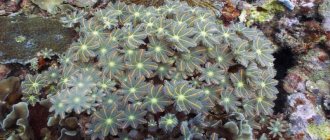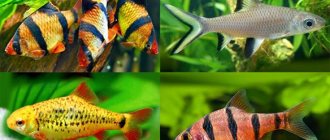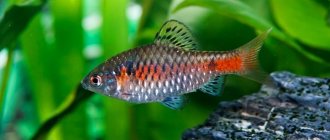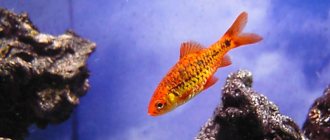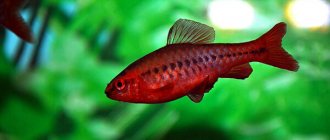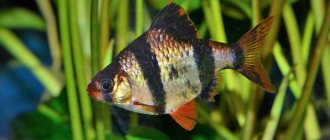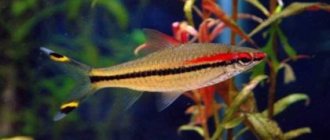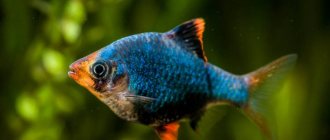Description
Cherry puntius or cherry barb is a species of fish belonging to the class of ray-finned fish and located in the cyprinidae family of carp. Belongs to the endemic (species found only in a certain area and nowhere else) of the island of Sri Lanka. Found in the waters of the Kelani and Nilwala rivers. Prefers clean reservoirs with clear and slowly flowing water. The bottom is most often covered with silt, in which a large amount of vegetation grows.
In the past, the water bodies on the island of Sri Lanka were changed by human activity, and the territories were used for their own needs. This led to the species being listed in the Red Book as being on the verge of extinction. With the help of nature reserves and captive breeding, the population has been restored.
These fish, originally from Asia, have been known to mankind for more than several hundred years. In the European part, their general popularity began in the 1930s. In the USSR they appeared closer to the 1950s.
Appearance
From the name of the species, the color of the fish immediately becomes clear - rich red-cherry. The color reaches its greatest brightness during the spawning period. And also the color changes depending on the physical condition. The color of fish living in natural conditions is much brighter than those bred in captivity. Along the sides there is a dark stripe that stretches from the head to the caudal fin.
These fish grow up to only 5 cm. Their body is elongated and oval with points in the head and tail. The dorsal, pelvic and anal fins do not differ in size or shape, and the caudal fin has the usual forked shape.
There are small mustaches near the mouth, which is why the genus was called barbels.
Breeders have developed a more perfect and beautiful form of cherry puntius - veiled cherry barb. The veiled specimen has long, flowing fins and a more striking coloration.
Behavior
Cherry puntius is a schooling fish. In the wild, flocks of puntius reach a couple of thousand individuals. When kept alone, the color of the fish turns pale and dull.
Behavior towards other representatives is peaceful and non-aggressive. Do not keep them with fish that have veil-like and long fins. The barbs bite them off.
Lifespan
The average lifespan of barbs is 4 years.
Other shapes and similar species
In aquariums you can find unusual artificially bred forms of the cherry barb - albino and veiled (with long fluttering fins and a bright body color). These are more delicate and whimsical fish than the ordinary barb and live much shorter - up to 4 years.
The veil barb does not tolerate the slightest deviations from the recommendations in the composition of the water.
Barbus Ticto (scarlet barb) has a color similar to cherry. These are peace-loving fish that get along best in a small school of 6-7 individuals. The fish are quite active and such a school requires an aquarium of up to 80 liters.
Another similar species is the fire barb. Adults can reach a size of 8-15 cm. They have a bright red color with a golden tint and clear scales. Fins with dark outline.
Feeding
In the natural environment, the diet of fish consists of crustaceans, insects, larvae, and some plants. When keeping a cherry barb in a home aquarium, the fish calmly eat food of any origin. A good diet option would be a combination of live food with a small amount of dry food, such as flakes or granules. Puntius also needs supplements in the form of plant foods, for example, vegetables, nettle leaves, lettuce, spinach, and dandelion.
Puntius are fed small portions a couple of times a day. Remember that cherry barbs are small in size and have a small mouth. Therefore, choose food with small particles or grind the food before feeding yourself. When feeding vegetables or leaves, be sure to scald them with boiling water to kill bacteria and soften food pieces.
How to keep
The reservoir should be filled with plants (fine-finned) abundantly, since the cherry barb is shy and likes to hide in thickets and decorative grottoes and snags. Vegetation is also necessary when breeding fish, since grown young animals are more protected among it. In areas without plants, fine-grained soil is desirable. Externally, the aquarium looks natural and elegant, imitating a piece of a river in a tropical forest. The cherry barb has a bright color only when properly maintained. Pets are mobile, and for them you need to choose an elongated aquarium. Its width is not so important; at the same time, the maximum length is required. Fish should be kept in a school of 7 or more individuals. Having accelerated while swimming, the pet can jump out of the reservoir and die. To prevent this, you need a lid. They tighten the top of the container with gauze, but this is ugly. Modern aquariums already have a lid with built-in lighting.
In the foreground, you need to leave the barbs a strip of free space for active swimming. The fish are shy, so you can’t place an aquarium in the aisle. Keeping cherry barbs in a group of less than 5 individuals also causes stress. This is due to the peculiarities of the life of fish in nature, where they feel safe only in a large school. The soil in the aquarium should not be made colorful or too light. A cherry-colored barb looks most advantageous on dark, almost black soil, which emphasizes the richness of its color. The place for the aquarium should be chosen so that natural light from the window falls well on it. This improves the growth of plants that are necessary for fish. The aquarium is cleaned weekly, with thorough cleaning of the soil and changing ¼ of the volume of water. Without such care, pets begin to suffer and often die.
See how barbs behave in a community aquarium.
https://youtube.com/watch?v=WiDgjSKsSig%3F
Compatibility
Cherry barbs are famous for their peaceful temperament and get along well with almost all other aquarium inhabitants, especially if they themselves do not show aggression. It is possible to keep fry of other fish together with barbs and not have to worry about their safety. But cherry fish themselves often become victims of attacks from other fish due to their size. For example, the poor compatibility of barbs with territorial angelfish and discus fish. Sumatran barbs should not be kept together either.
A post shared by Pablo Sebastián Elarca (@elarcapetshoplujan) on Jun 5, 2021 at 1:09pm PDT
Spawning of cherry barbs
It is better to prepare the spawning of cherry barbs in the evening, counting on the morning hours. The signal for the start of spawning can be the entry of natural morning light into the spawning area. It is recommended to close the spawning tank to prevent fish from jumping out during heavy spawning.
Spawning lasts 2-3 hours. One female cherry barb lays up to 200 eggs
After spawning, we remove the protective net, and if plants were used as a substrate, they can be left and carefully removed after the fry swim. If the eggs have been successfully fertilized, the larvae will appear in 2 days, and after another 1 day the fry will swim and you need to be prepared for this moment
Starter feed
As a starting food for cherry barb fry, it is better to use complete live food: slipper ciliates, rotifers or brine shrimp. The worst, but quite acceptable option would be to feed the fry with boiled egg yolk.
Preparing this food is very simple: hard boil a chicken egg and separate the yolk, cut it in half and rub it over the surface of the yolk with a watercolor brush dipped in water and rinse it in a jar of water. When the yolk microparticles settle, drain the cloudy water and fill with clean water.
After the drained water becomes clear, carefully pour the settled yolk particles onto the compressor sprayer for the fry.
Good and useful helpers for cleaning the bottom of the aquarium from uneaten yolk particles will be ampularia snails or a small Ancistrus catfish. These orderlies must be assigned to the fry. From the first days of feeding the fry with yolk, add Daphnia moin. Small newborn crustaceans will become available for consumption already on the 3-4th day of the fry’s life, which will become noticeable by the swollen abdomen.
Later, you can alternate daphnia with grindal, as well as cut and well-washed aulophorus. Growing fry need to be placed in additional aquariums, otherwise their growth will begin to be delayed. It is necessary to move grown fry to adult fish only when the fry reach 1.5-2 cm in size and make sure that no treacherous neighbors are waiting for them in the new aquarium.
You cannot release all the fry at once. To begin with, release only 1-2 fish and, if after a day they are not pursued by adult fish, then you can release the rest. Otherwise, you need to catch and return the fish to their place for further growing or relocate the bullies.
Reproduction
Puberty occurs at six months, and individuals are ready to reproduce at 9-12 months. To reproduce cherry puntius, there must be 2 males per female. To breed barbs, you will have to create more favorable conditions in the aquarium or place several fish in a separate spawning tank. A week before spawning, the fish are fed heavily and the water temperature is increased. It is advisable to ensure a complete absence of stress. When setting up a spawning tank, you should lay a net on the bottom through which the eggs will fall, and place vegetation on top of the net.
Features of aquarium living
The scarlet barb is not a loner; the fish feels most comfortable when surrounded by its fellow fish. The smallest flock that can be kept in an aquarium should consist of 6 individuals. If you take this feature into account, the fish will not be stressed, quickly adapt to new conditions and create an appropriate hierarchy. They will be able to fully demonstrate their abilities and character.
A couple of barbs will turn out to be modest, shy fish, with inexpressive coloring and uninteresting behavior. Moreover, individuals will constantly experience stress and often get sick. When equipping a home for barbs, you can adhere to the following recommendations:
- the length of the aquarium must be at least 60 cm;
- the front of the tank and the middle must remain free;
- It is advisable to plant vegetation near the back wall and sides;
- a filtration system for the container is necessary - it will not only purify the water, but also ensure the necessary flow;
- We must not forget about regular water changes;
- pH value – 5-7.0;
- hardness – 5-15;
- water temperature – 20°-25°С (other barbs prefer a warmer water environment).
The tank needs to be decorated - barbs love to hide, in addition, some structures are capable of spraying or filtering water. When selecting decor, it is necessary to avoid toxic materials and products with sharp edges and corners. Also, the devices should not have narrow holes or passages in which these nimble fish could get stuck.
Diseases
Resistance to most diseases is a distinctive feature of barbs. They have a strong immune system that helps them survive in adverse conditions. With improper and inappropriate care, barbs can contract various diseases.
- Lack of aeration system. There are fish that are able to breathe air at the surface, but most species require aeration.
- Lack of a filter and rare water changes in the aquarium.
- Incorrect ratio of aquarium volume to number of fish.
- Poor quality food, which is most often contaminated with infections.
- Failure to comply with hygiene rules, entry of infected plants and decorations.
- No quarantine for purchased fish.
- Incorrect organization of spawning.
The most common diseases affecting the body of cherry barbs:
- White-skinned.
- Gill rot.
- Rubella.
White-skinned
White-skinned is an infectious disease that affects the body of the fish, the color of the pet changes. Its skin becomes whitish or yellowish near the caudal fin and on the back.
The disease easily spreads throughout the aquarium from one sick fish to another, so if you notice signs of the disease, immediately begin treatment and remove healthy fish. Secondary symptoms are considered
- Lethargy of fish.
- Decreased appetite.
- The individual is on the surface of the water.
- Problems with coordination due to disruption of the nervous system.
Tips for keeping aquarists
- It is not recommended to place the aquarium in a walk-through place - constant movement near the tank can cause stress in the fish and rapid death. A comfortable location is in a corner where the fish will be protected from prying eyes on at least two sides.
- In order for your pets to feel good, it is necessary to clean the pond every 7-10 days. To do this, it is necessary to siphon away any remaining feed and debris and replace a third of the volume of water with fresh, settled water.
- Puntius titteya loves shaded aquariums and dim light. Plants floating on the surface of the water will help create shade. Dark soil will help to avoid bright light - this way the fish will feel more comfortable and look much brighter.
Previous
Cardinal fish - a problem-free aquarium inhabitant from Southern China
Next
Fish Cichlazoma Meeka - an intelligent and curious aquarium inhabitant
Reviews
Cherry barbs are considered the most calm and peaceful inhabitants of the barb genus. Breeders note that their pets are not known for being destructive or excessively whimsical and selective. These inhabitants are omnivores, so there are no problems with feeding. There are no particular problems with reproduction either. And everyone also notes the exquisite beauty of this fish, its red-cherry color.
Habitat
Cherry punt (barb) is a tropical Asian fish native to Sri Lanka. This lover of warm waters received its tasty name due to its juicy bright cherry color - only males reach the peak of color and brightness during breeding periods. It has been proven that in natural habitats, barbs have a more saturated color than their aquarium relatives. The fish prefers reservoirs protected from sunlight - therefore it lives exclusively in shaded waters with slow currents.
Did you know? The rarest and most expensive aquarium fish on the planet is the dragon fish. The price for a regular specimen ranges from $50,000 to $80,000, depending on the rarity of the color. But a platinum-colored dragon fish costs up to $400,000!
Familiarize yourself with the rules for caring for such common aquarium fish as: clownfish, veiltail, goura, guppy, barb, parrotfish, persimmon, mollies, goldfish, swordtail, platie, zebrafish, cockerel, astronotus, lalius, minora, discus , arowana, surgeonfish, dario dario, angelfish, macropod, macracanthus, cichlids, rhodostomus and labeo.
Photo gallery
Breeding
It is very easy to distinguish a male from a female: males are slimmer and have an intense red color, which becomes brighter during spawning. The abdomen of females is round, full, and their coloring is more modest.
Under good conditions, cherry barbs can spawn in a community aquarium without any care from the owner, but in this case, most of the offspring will be eaten by the parents and other inhabitants.
To increase the survival rate of fry, it is necessary to resort to the help of a spawning tank - a small container isolated from other inhabitants. In such conditions, it becomes possible to control spawning.
The spawning tank should be dimly lit, and its bottom should be lined with substrate:
- rug imitating vegetation;
- layer of glass beads;
- living plants with small foliage: pinnate, moss, hornwort, etc.
A separator net is placed on top of them, the mesh of which should be large enough for the eggs to fall into it, but at the same time not allow the parents to reach the eggs. The optimal temperature for spawning is 26 ° C, and the water should be soft, neutral or sour. It is recommended to install a filter and aerator.
Before spawning, producers are advised to increase the proportion of high-protein live or frozen food in the diet, as well as increase water changes.
Sexual differences in cherry barbs. On top is a male with a bright ruby color, and below is a female, her coloring is somewhat more modest.
A small group of the brightest and largest fish is deposited in the spawning tank. As soon as eggs form in the abdomens of the females, the barbs split into pairs and begin spawning, which begins early in the morning. The female lays eggs on the substrate, which are immediately fertilized by the male. After spawning, the spawners must be removed as soon as possible, otherwise they may eat the eggs.
Incubation of eggs lasts 24-48 hours, depending on the water temperature. For the first 24 hours, the larvae feed from the yolk sac, after which they begin to swim around the aquarium in search of food. At this time, you need to start feeding them with grated yolk or “live dust”, and after a few days you can offer them food of a larger fraction - artemia and cyclops nauplii or microworms.
There is no need to limit the fry's food. Feeding should be organized 4-6 times a day in small portions. Remains of food should be removed an hour after feeding, and water changes should be small - about 10%, and frequent - up to 4 times a week.
Sexual Dimorphism
The cherry barb reaches sexual maturity at the age of 6-8 months.
Cherry barb (Puntius titteya) male.
It is not difficult to distinguish females from males, since females are slightly larger than males and are more modestly colored.
Cherry barb (Puntius titteya) female.
Male cherry barbs have a bright reddish abdomen, while females have a lighter flint-yellow abdomen. In addition, females are plumper than males and have a reddish dorsal fin with two arched black stripes.
Who do barbs get along with?
Even large fish of this breed cannot be called aggressors. Of course, misunderstandings can arise within the “family” of barbs, and there are situations when these peace-loving inhabitants react sharply to their neighbors. However, if you choose the right inhabitants, such troubles can be avoided.
When in a bad mood, the barb can “ruffle” the luxurious fins and tails of other inhabitants. And while smaller, more nimble guppies and bettas can escape from an angry neighbor, slower veiltails, telescopes and angelfish can be seriously harmed. Not the best company is made from active, mischievous “mustache” and cowardly, inert lalius. And you shouldn’t expect peace with the brawling astronotuses - in this case, competition will definitely arise.
Of course, it is best to have a flock or several barbs - they are more impressed by such conditions. But if these fish are supposed to be kept in a common tank, you can place them with platies, parrots or mollies. They have a similar character and lifestyle, so they can coexist in the same territory without any problems.




